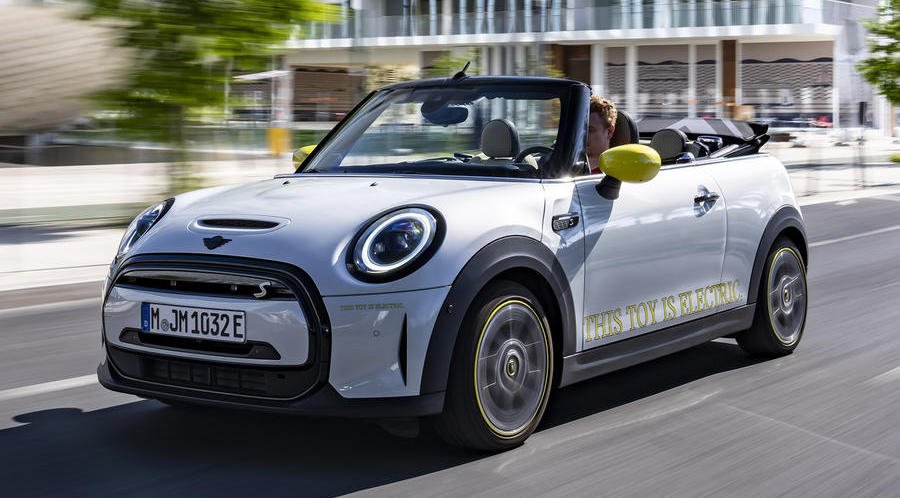BMW mulls Mini Electric Convertible for next generation

BMW has built a one-off pure-electric version of the current Mini Convertible to test the market for a potential next-generation model.
According to the company, "the one-off Mini Electric Convertible is a prototype, to test the waters of emission-free, open-top driving with Mini".
The prototype uses the current Cooper S Convertible upper structure but is based on the powertrain components of the Mini Electric and was built in Munich.
This means that the prototype Mini Electric Convertible has a 181bhp electric motor and a range of up to 145 miles (WLTP), which is the same as the production Mini Electric.
And that’s despite this convertible weighing 140kg more than an automatic combustion-engined Cooper S convertible. The boot capacity remains unchanged at 160 litres.
Despite these encouraging numbers, BMW says the current Mini Convertible will not be electrified. All the company will say on the record is that there will be a new convertible model: "We have announced that the Mini Convertible is to receive a successor, but it is too early to speak about the engine portfolio of an upcoming replacement for the current Mini Convertible."
However, BMW sources told Autocar that a production electric convertible is entirely on the cards as a sibling to the upcoming new-generation Mini hatchback EV, which is being built on a bespoke platform as part of a joint venture with Chinese car maker Great Wall.
The new electric Mini, which is at least 18 months away, will come as a three-door model as standard, making it the ideal basis for a convertible model. The wheelbase of this three-door architecture is also 40mm longer than today’s car, which should improve the ride as well as noticeably increase space in the rear.
This stretch also means that any production Mini Convertible would have a significantly bigger battery than this one-off prototype. The EV platform has allowed the current Mini’s long front overhang to be significantly reduced while passing future crash tests.
As Autocar reported earlier this year, the future electric convertible will have a bigger battery, with the equivalent Cooper model getting a 40kWh battery. Any Cooper S convertible could get a battery as big as 50kWh and a real-world range of 250 miles or so, as well as very strong performance.
Officially, BMW sources would not divulge any more detail about this fourth-generation Mini derivative, although Autocar has learnt that a number of the classic Mini design cues will be dropped on the next-generation model, including the clamshell bonnet that has featured since BMW relaunched the brand in 2001.
One source told Autocar that the large bonnet pressing was expensive to produce as well necessitating the inclusion of the substantial chrome rings around the Mini’s headlights, which are an essential part of the lamp-bonnet alignment set-up.
With Mini design chief Oliver Heilmer moving to reduce the complexity of the fourth-gen Mini’s exterior and interior design, the removal of the clamshell bonnet not only saves money and speeds up construction time, but it also allows the chrome headlight bezels to be ditched.
The bezels around the rear lights will also be dropped for the fourth-generation design, as will the distinctive separate panel in front of the Mini’s front doors.
Even though the three-door Mini EV and Mini ICE hatchbacks are based on entirely different architectures, they will both share the stripped-back interior that has been developed under Heilmer. Sources say the Mini’s circular speedo will survive as a touchscreen and other switchgear will be significantly reduced, including the axing of the BMW-style circular controller.
What is an electric Mini Convertible like to drive? We take it for a spin
For a one-off prototype, this electric Mini Convertible is really remarkable. It looks and feels like a proper production car. The doors slam beautifully and the whole car moves with a fine precision that suggests it has undergone serious development. And we shouldn’t forget just how generally well made the current Mini range is, especially at its price points.
Our drive was a short run from a Portuguese hotel to the sea and back, but it was enough to know that adding electric running gear has done two things.
Firstly, this car felt immensely stiff and of a piece. There wasn’t the meerest hint of scuttle or steering column vibration, even driving over cobbles.
Is that a consequence of a large battery pack being bolted into the floor structure? Mini staff weren’t saying much, but it was hugely impressive and made the little Mini feel much bigger and grown-up. The overall rigidity also made it easy, and very satisfying, to spear the car around tight bends with great precision.
The second big takeaway for me was how well the seamless powertrain suited the open-top car. One of the most interesting uses of pure-battery power must be for sporting vehicles. After driving this car around some winding and hilly lanes, it has to be said that the lack of gearshifting and the near-endless shove really do work, especially in a short and swift open-top car.
This prototype is based on existing architecture, so the new model will be at least as good. It left me wondering if there might be room for some kind of Speedster version of the fourth-gen Mini EV convertible. From this brief encounter, it’s an unexpected gem.
